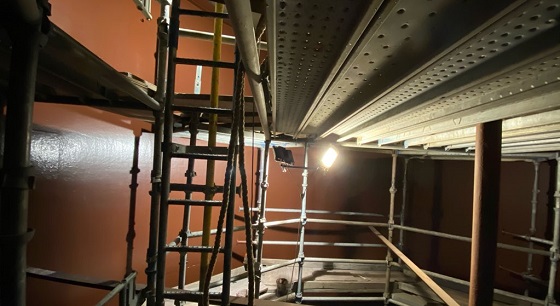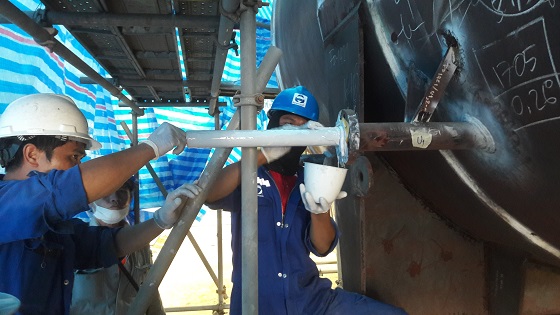Operational conditions in the lucrative petroleum refining industry along the Texas Gulf Coast aren’t for the faint of heart. Between producing and storing harsh chemicals and the moist and humid environment outside, corrosion concerns are constant.
As a result, during maintenance turnarounds, many refiners have specialists they regularly contract to mitigate these concerns. For one major Houston-area refiner, that specialist is the team at nearby BHI Coatings, which functions as an approved applicator for industrial protective coatings and composites company Belzona.
“We have a consultant assigned to this particular refinery, and he learned they were having issues with hydrogen grooving in this acid tank,” said Breanna Remmers, president of BHI. “It’s 96% sulfuric acid. Some of the weld seams were becoming corroded, and they didn’t have another product that could hold up to the concentration of sulfuric acid.”
Multiple areas of the 1,900-square-feet (176.5 m2) carbon-steel tank displayed pitting.
Refined Safety Plan
Using six crew members and two NACE-certified inspectors, BHI’s team hit the ground running in November 2020. To mesh with the refiner’s business plan, they needed to work quickly, since all work was to be completed during a temporary turnaround period.
The timing added to the complexity, since it was during the early stages of the COVID-19 pandemic and at a time of changing weather patterns around Houston. Masks and daily testing were conducted, while climate control and power generation equipment was procured from Sunbelt Rentals. This included a combination air conditioning and heating unit, allowing them to adjust to a given day’s conditions, along with dehumidification technologies.
Standard personal protective equipment (PPE) was worn throughout the project, including fall protection gear, goggles, flame-resistant clothing, ear plugs, steel-toed boots, and respirators while spraying. Safety gear was acquired from 24Hr Safety, LLC.
Crew members underwent specialized, site-specific training, since they were working adjacent to three active sulfuric acid tanks. For example, this meant no hot work was allowed, so the tank was vapor blasted.
“We do very hands-on training with our crews before they go into the field,” Remmers said. “With this tank, we ended up doing nozzle inserts, as well. This work is very specialized. Not just any contractor could do it.”
“When it comes to Belzona, each coating has a little bit different personality to it,” added Alex Tzamtzis, BHI’s vice president of technical support. “Coating by coating, we go over how to use it and the best way to apply it… to get the optimal working life, and to get it right.”
Prep Makes Perfect
With safety plans in place, first on the agenda was surface preparation. The objective was to achieve the NACE No. 2/Society for Protective Coatings (SSPC) Surface Preparation (SP) 10, “Near-White Metal Blast Cleaning” standard with a 3-mil (76.2 microns) anchor profile.
The crew rented a Schmidt AmphiBlast machine from Allredi with garnet abrasive, with deionized water injected into the blast stream after its metering valve. “It’s a bit upgraded from your traditional vapor blasters,” said Ethan Perkins, vice president of operations and this job’s project manager. “It’s a much better design, easier to operate, and a simpler machine.”
Given this tank’s environment, it wasn’t a smooth process, and it required multiple blasting rounds and even more pressure washing.
"Originally, we did like 10 test pots and tested for chlorides, sulfates, and nitrates,” Tzamtzis said. “The chlorides were a little high, there were no nitrates, but the sulfates were really high. So we went ahead and blasted the tank… to clean down to bare metal. Then, the chlorides came back at zero, but the sulfate was still high. So we did two more rounds of hydrocleaning with deionized water and salt removal. Only after the third time did we get it within our [desired] parameters, and then we blasted again. So there were two full blasts, and we still needed that pure 10,000 [psi, or 689.5 bar] pressure cleaning to really get them out.”
“If we don’t get good prep, it doesn’t matter how good our products are,” Perkins surmised. “That’s the key. We had a lot of difficulty pulling the sulfates out of the metal. That probably took an extra four days.”

Work Scope Grows
Once surfaces were prepped, application specifications varied depending on the location. The interior was protected with Belzona 4311, a two-part epoxy coating, while Belzona 4301 — a paste-grade version — was used for pitting.
“For the internal liner, one of the keys was to reset the sulfuric acid resistance,” Tzamtzis said. “But it also had to resist hydrocarbons because it was an alkylation tank. They also required a higher temperature resistance because it gets hot in Texas. Sometimes it’s hard to find a product that can be able to resist different types of chemicals in the same service.” For temperature resistance, the crew brought in a large, force-cured heater.
Using a heated, plural component Graco King airless sprayer, the 100% solids interior coating was applied in two coats at approximately 15–20 mils (381.0–508.0 microns) dry film thickness (DFT). A stripe coat was applied to welds.
“You can spray 1,900 square feet pretty quick, especially when you have a No. 6 fan tip on your gun,” Perkins said. “Each day, it would take about three hours to get everything set up. Then it took two or three hours to spray all the walls. We would let that sit overnight and come back in the morning. We had a 24-hour overcoat [window], so we would put the second coat on, and we were able to start doing some soft inspections that afternoon. This sets up so quick.”
“The floor is a little different because you have to walk on it,” Perkins said. “It was pretty much the same process, just spaced out a few more hours.”
The paste grade was installed at approximately 1/8-inch (0.3 cm) of thickness. “We’re basically just trying to get it back flush with the existing wall,” said Perkins. Meanwhile, the stripe coat was applied with 0.75-inch (1.9 cm) cut bristle brushes. “Because our coatings are so thick compared to regular paint, it’s hard to move them around with normal bristles.”
As with any application, interior or exterior, the key was crew members working together. “It all starts with your lead spray guy,” Perkins said. “He’ll be on the gun, putting the product on. The idea is to make it look pretty, like glass. After that, we’ll have our hole watch [person] for the confined space. We’d have another man at the manway to watch from the outside, with someone else inside being what I call the ‘tag man.’ He keeps the lines pulled away so that nobody trips, and we don’t get tangled. And if anything happens, we can communicate from inside to outside. Usually one man at the pump is all we need, and he’s watching gages and making sure the hopper stays full.”
The exterior was protected with Belzona 5811, an immersion-grade epoxy, followed by an epoxy intermediate coat and International’s Interthane 990V polyurethane topcoat for ultraviolet (UV) resistance and color matching. “The existing coat, I think it was called misty blue,” Perkins said. “Most of our coatings are not really colored, because they’re not pretty paints. They’re more about performance.”
The Belzona 5811 went down in two coats, each at at 10–12 mils (254.0–304.8 microns) DFT, followed by the intermediate at 6–8 mils (152.4–203.2 microns) and the topcoat at 2–3 mils (50.8–76.2). The Belzona 1121 metal repair composite, which features a solvent-free epoxy resin reinforced with silicon steel alloy, was used to rebuild areas of roof pitting.
“The exterior coating takes quite a bit of a beating because of the atmosphere there,” Tzamtzis said. “They’ve got a lot of hot steam, and probably traces of chemicals. So that’s why we put a base layer, because it can handle those, even if the topcoats fail over time.”
The job’s original scope was just for the interior lining, but it quickly expanded to include the exterior roof, nozzle inserts, and manway, which expanded the project’s duration. Upon opening the tank, they noticed corrosion due to hydrogen grooving. This led to the application of Belzona’s SuperWrap II composite repair system, which works as a carbon fiber wrap for the manway. As with areas of interior pitting, the 4301 was used for nozzle inserts.
“They had brought up wanting to coat the nozzles, and protect them instead of putting new ones on,” Perkins said. “Just imagine trying to coat a nozzle that’s an 1.5-inches (3.8 cm) wide by 12 inches [30.5 cm] long, and making sure it’s coated right. It’s almost impossible. That’s when we start bringing up our inserts. These inserts are typically 3/16-inch [0.5 cm] thick tubes, essentially, so you’re getting plenty of meat back in that nozzle.”

Trendy Turnaround
Thanks to the expanded work scope, the job lasted approximately three weeks. But that still worked within the confines of the planned turnaround, and that has led to a happy client — and one that hasn’t had problems since.
“They’re going to inspect it in 10 years,” Tzamtzis said. “Normally, at that point, there might be a little bit of wear and tear. But the coating should be intact. This coating should not be attacked by chemicals throughout its lifetime.”
For BHI, the proof is in the contracts.
“They were very happy with it,” Perkins said. “We handled everything as good as we could, which was above and beyond their expectations, I believe. We’re still in there today. We’ve probably done 30 projects after that, ranging from one-day to one-week projects.”
“They’re still one of our largest clients,” Perkins concluded. “So that’s good news.”